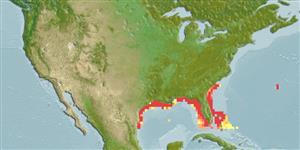>
Blenniiformes (Blennies) >
Dactyloscopidae (Sand stargazers)
Etymology: Dactyloscopus: Greek, daktylos = finger + Greek, skopein = to look (Ref. 45335).
Eponymy: Clarence Bloomfield Moore (1852–1936) was an American archaeologist, particularly noted for his studies of Native American sites. [...] (Ref. 128868), visit book page.
More on author: Fowler.
Environment: milieu / climate zone / depth range / distribution range
Écologie
marin démersal; profondeur 3 - 35 m (Ref. 27742). Subtropical; 33°N - 24°N
Western Central Atlantic: North Carolina to Florida Keys and Texas in the Gulf of Mexico.
Taille / Poids / Âge
Maturity: Lm ? range ? - ? cm
Max length : 8.0 cm TL mâle / non sexé; (Ref. 7251)
Épines dorsales (Total) : 11 - 13; Épines anales: 2; Rayons mous anaux: 30 - 35. Common amongst Dactyloscopidae: Small, elongate fishes. Head usually broad and deep, body tapering and compressed behind. Eyes on top of head, often protrusible; mouth moderate to large, oblique to vertical; upper and/or lower lips with fimbriae; jaw teeth minute, in 2 or more series; no teeth on roof of mouth (vomer and palatines). Opercular opening large, gill membrane free from isthmus; opercles membranous, large, usually overlapping on underside of head, typically fringed above with 2 to 24 fleshy fimbriae. Dorsal fin continuous, with an isolated or semi-isolated anterior finlet, or with 1 to 5 separate anterior rays; dorsal-fin spines 7 to 23; anal-fin spines 2; dorsal and anal fins free or united to caudal fin by fragile membranes; pectoral fins broad-based, usually enlarged in mature males; caudal-fin rays simple or branched; pelvic fins under throat (insertion anterior to pectoral-fin base), with 1 spine and 3 thickened segmented rays; all other rays simple. Head and venter naked, body elsewhere with large cycloid scales (smooth to touch); lateral line high anteriorly, deflecting ventrally behind pectoral fin to continue along middle of side to caudal-fin base where terminal lateral-line scale bears ventrally directed canal. Body coloration, variably pale to strongly pigmented with white, brown, or reddish; some forms with characteristic saddle-like bars crossing back; others plain, mottled, or with indications of lateral stripes. Species distinguished by: dorsal-fin origin on nape; without a distinct anterior finlet; dorsal-fin spines usually 11 to 13. Segmented anal-fin rays 30 to 35 (usually 31 to 34). First preopercular canal branched, with 2 or more distal pores. Posterior naris (a single pore) located on anterior rim of preorbital, adjacent to base of tubiform anterior naris; premaxillary pedicels reach well past rear margins of orbits. Expanded eyestalk not exceptionally long and slender. Eye without a distal ring of translucent spots or dermal flaps. Upper lip fimbriae usually 13 to 17. Two to 4 rows of scales on each side of nape anterior to first dorsal-fin spine base (midline of nape naked) (Ref.52855).
Burrows in soft sandy bottom, where it waits for prey, with only the eyes, nose and mouth protruding.
Life cycle and mating behavior
Maturité | Reproduction | Frai | Œufs | Fécondité | Larves
Dawson, C.E., 1982. Atlantic sand stargazers (Pisces: Dactyloscopidae), with description of one new genus and seven new species. Bull. Mar. Sci. 32(1):14-85. (Ref. 27742)
Statut dans la liste rouge de l'IUCN (Ref. 130435: Version 2024-1)
Menace pour l'homme
Harmless
Utilisations par l'homme
Pêcheries:
Outils
Articles particuliers
Télécharger en XML
Sources Internet
Estimates based on models
Preferred temperature (Ref.
123201): 23.4 - 26.5, mean 24.1 °C (based on 100 cells).
Phylogenetic diversity index (Ref.
82804): PD
50 = 0.5000 [Uniqueness, from 0.5 = low to 2.0 = high].
Bayesian length-weight: a=0.00389 (0.00180 - 0.00842), b=3.12 (2.94 - 3.30), in cm total length, based on all LWR estimates for this body shape (Ref.
93245).
Niveau trophique (Ref.
69278): 4.3 ±0.6 se; based on size and trophs of closest relatives
Fishing Vulnerability (Ref.
59153): Low vulnerability (10 of 100).
